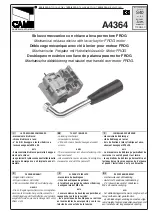
piece (A) can now be easily changed or the
clamping mechanism serviced. Press the
trigger briefly and the tool moves to its starting
position again.
2. Auto and Manual mode: In Manual mode, hold
the trigger depressed during setting of the
rivet until the mandrel is sheared off. In Auto
mode you only have to press the trigger briefly
and the riveter controls the riveting process
automatically. To change from one mode to the
other, hold the trigger pressed for 10 seconds
(until the white LED on the tools starts to flash
2/sec) and release again. Press the trigger
briefly and the tool moves to its starting positi-
on again.
MALFUNCTION
If rivets are used beyond the specified performance
capability of the riveter, the riveter stops and the
red LED (D) comes on. Wait until the LED (D) goes
out and press the trigger briefly again. The tool
then moves to its starting position again.
When the battery (F) is discharged, the riveter is
protected by a protection circuit. The riveter com-
pletes the cycle and then stops. The LED (D) lights
up yellow. Replace the discharged battery with a
charged battery (F). The yellow LED (D) goes out
and you can continue to work.
STUD HOLDER
Both riveters are equipped with a safety switch,
the “stud holder”, and thus conform also to the
Machinery Directive. This prevents the riveter being
used without stud collector (E). Never operate the
riveter without stud collector (E) or stud securing
cap (J). Never bypass the safety switch. If you have
to work in confined spaces, the stud securing cap
(J) can be fitted instead of the stud collector (E).
When working with stud securing cap (J), hold the
riveter with the nose piece (A) facing downwards
after each set rivet to ensure that the sheared
mandrel drops out of the riveter to the front. Do not
use fixed or retainer nose pieces together with the
stud securing cap (J). This would result in damage
to the riveter!
HANGER CLIP
If you wish to use the riveter on a balancer, you
can attach the hanger clip supplied (K) to the two
bores (C) provided. Take care not to stretch the
hanger clip (K) too far apart so that it does not lose
its tension. Check that the hanger clip (K) is fitted
securely before using the riveter.
BELT CLIP
Attach the belt clip (O) to the foot of the riveter us-
ing the screw (M). A corresponding thread and two
slots (L) are recessed in the foot of the housing on
both sides of the riveter. Check at regular intervals
that the clip (O) is still securely attached, otherwise
retighten the screw (M).
MAINTENANCE AND SERVICE
SERVICING AND CHANGING THE CLAMP-
ING JAWS
Depending on the mandrel material, shear force
and surface finish, the clamping jaws have to be
cleaned and replaced at regular intervals.
I Loosen and remove front sleeve (B) using a
SW 27 comination wrench.
II Loosen and remove clamping sleeve (1) from
adapter (3) using two SW 17 combination
wrenches and remove the 3-piece clamping
jaws (2) from clamping sleeve (1). Clean clam-
ping jaws (2) and inspect for wear. Replace
clamping jaws (2), if necessary.
III Clean the inside and outside of clamping slee-
ve (1). Grease the inside of clamping sleeve
(1) lightly with graphite grease using a brush
(4).
IV Place clamping jaws (2) into clamping sleeve
(1).
Install clamping sleeve (1) with clamping jaws
(2) on adapter (3) again and finally fit front
sleeve (B).
Important:
Tighten the clamping sleeve using two
SW 17 combination wrenches to ~22 Nm, other-
wise the gearing may be destroyed!
10
| English
Summary of Contents for Marson BT-2A
Page 2: ......
Page 3: ......
Page 4: ...4 h l2 d B C D E A I H G F O M L l1 b ...
Page 5: ... 5 C B 1 4 3 2 B 3 2 1 B 3 1 2 IV III I II K J ...
Page 27: ......











































